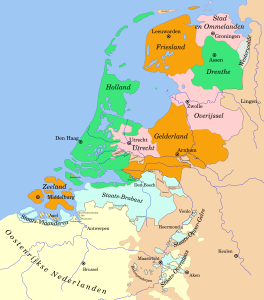Almost everywhere in the world today, we use the Gregorian calendar. It has 365 days a year, with the occasional leap year that is determined as follows:
Every year that is exactly divisible by four is a leap year, except for years that are exactly divisible by 100, but these centurial years are leap years if they are exactly divisible by 400. For example, the years 1700, 1800, and 1900 are not leap years, but the year 2000 is.1
This calculation of the leap years make sure that the average length of the year matches the time it takes the earth to revolve around the sun.
Before the Gregorian calendar, most countries including the Netherlands, used the Julian calendar. This was just a little less accurate, so over time the changing of the seasons misaligned with the calendar date, leading to a shift of 11 days by 1582 and 12 days by 1700. When the Gregorian calendar was introduced, those days were skipped to correct this shift.
Most countries adopted the Gregorian calendar between 1582 and 1701. One of the last countries to adopt the Gregorian calendar was Russia, after the October-revolution of 1917, which actually took place in November on the Gregorian calendar.
Introduction of the Gregorian calendar in the Netherlands

Map of the Republic of the Seven United Netherlands. Image credits: Joostik, Wikimedia Commons
Interestingly, the Gregorian calendar wasn’t introduced in the Netherlands all at once. In 1582, protestant people under the leadership of William of Orange tried to free themselves from the Spanish (Roman Catholic) rule.
In general, the provinces under the control of the Spanish (Roman Catholic) King introduced the Gregorian calendar in 1582 while the provinces under the Orange (Protestant) rule introduced the Gregorian calendar in 1700/1701, but even then they did not all do it on the same date.
The following table shows the exact dates when each province introduced the Gregorian calendar:2
| Province | End date Julian calendar | Start date Gregorian calendar |
|---|---|---|
| Brabant, Zeeland | 14 December 1582 | 25 December 1582 |
| Limburg | 20 or 21 December 1582 | 31 December 1582 or 1 January 1583 |
| Holland | 1 January 1583 | 12 January 1583 |
| Groningen | 10 February 1583 | 21 February 1583. Returned to Julian calendar in the summer of 1594. |
| Gelderland | 30 June 1700 | 12 July 1700 |
| Utrecht, Overijssel | 30 November 1700 | 12 December 1700 |
| Groningen | 31 December 1700 | 12 January 1701 (second time). |
| Friesland | 31 December 1700 | 12 January 1701 |
| Drenthe | 30 April 1701 | 12 May 1701 |
Implications for research
When you encounter a date in original records that is between 1582 and 1701, it could be in either the Julian or the Gregorian calendar, depending on the location. Some records use double dates (i.e. 10/21 July 1583) but those are rare. You will need to find out where the record was created to determine whether the date was in the Julian or in the Gregorian calendar.
Most genealogists just enter the date as they find it in the record, regardless of the calendar. If you encounter a Julian date and calculate the accompanying Gregorian date and use the calculated Gregorian date in your publication or database, be sure to make a note about that.
Usually, you don’t get in trouble when using the Julian date without converting it to the Gregorian date, but it can be significant if you want to find out what day of the week a certain event took place. For example, you might get suspicious if a church baptizes children on a Thursday only. Chances are, those dates are in the Julian calendar and the corresponding Gregorian date is 11 days later, on a Sunday. When in doubt, refer back to the table above and check which calendar was in use at the time.
Sources
- Wikipedia (http://en.wikipedia.org), “Gregorian calendar,” rev. 09:18, 18 May 2014
- Wikipedia (http://nl.wikipedia.org), “Lijst van invoeringsdata van de gregoriaanse kalender per land” [List of introduction dates of the Gregorian calendar per country], rev. 18:24, 13 February 2014


Thanks for this detailled info! I assumed Gelderland was the last province to convert to the Gregorian calendar, but I was wrong (albeit for just some months). Never to old to learn something new!